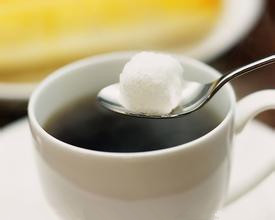Coffee knowledge is an evergreen shrub of Rubiaceae.
Coffee (scientific name: Coffea arabica), also known as coffee tree, Arabica coffee, etc., is the national flower of Yemen. Before the 6th century in the park, Yemen was called Arab, so the coffee trees transported from them to other places were also called Arabian coffee trees. The name coffee comes from the Arabic word "Qahwah", which means plant drink. Later, coffee spread all over the world and was named after its place of origin, "Kaffa". It was not officially named "coffee" until the 18th century.

It is an evergreen shrub of Rubiaceae in plant taxonomy. Lateral branches extend horizontally, opposite, occasionally three whorls; simple leaves opposite, flowers are 2-10 clumps in leaf axils, the fruit is drupe oval, the first fruit is dark green, yellowish red or purplish red when ripe, the fruit of coffee is formed by pericarp, pulp, endocarp, silver peel, and the seeds (coffee beans) wrapped in the innermost layers mentioned above, the seeds are located in the central part of the fruit, and the parts outside the seeds are of little use.
The world's first coffee tree was found in the Horn of Africa. Coffee cultivation began in the 15th century. For hundreds of years, Yemen in the Arabian Peninsula is the only coffee producer in the world, and the market demand for coffee is very strong. In the Yemeni port of Moka, when coffee is shipped out, it often needs to be protected by heavy troops. At the same time, Yemen has also taken various measures to prevent coffee saplings from being taken out of the country. Despite many restrictions, Muslim pilgrims on the pilgrimage to the holy city of Mecca secretly brought coffee saplings back to their hometown, so coffee soon took root in India. At that time, in Venice, Italy, countless merchant ships traded perfumes, tea, leaves and textiles with merchants from Arabia. In this way, coffee spread to a wide area of Europe through Venice. Many European businessmen have become accustomed to drinking coffee. Later, small vendors peddling coffee appeared on the streets of many European cities, and coffee gained rapid popularity in Europe. In the 17th century, the Dutch introduced coffee to their colony of Indonesia. At the same time, the French began to grow coffee in Africa. Today, coffee has become the second largest trading product on the earth after oil! Among the countless legends of coffee discoveries, there are two legends that people are most interested in talking about, namely, the Story of the Shepherd and the Arab Monk.
Three major coffee growing areas in the world: Africa, Indonesia and Central and South America. Yemen is the first country in the world to produce coffee on a large scale as a crop. The method of cultivation and treatment of mocha coffee in Yemen today is basically the same as that of hundreds of years ago. On most coffee farms in Yemen, coffee farmers still resist the use of artificial chemicals such as chemical fertilizers. Coffee farmers plant poplars to provide shade for coffee to grow. Coffee trees are planted on steep terraces to maximize the use of less rainfall and limited land resources. Yemeni mocha beans are still shipped in a bag made of straw, unlike chemical woven bags in other places.
Yemeni coffee has been cultivated for more than 2000 years. According to statistics, coffee is cultivated in 76 countries in the world. Coffee in China was first introduced in Taiwan in 1884. In 1908, overseas Chinese brought back large and medium seeds from Malaysia to Hainan Island. At present, the main cultivation areas are Yunnan, Guangxi, Guangdong and Hainan.
Small grains of coffee
[scientific name]
The small seed is Coffea arabica L., the medium grain is Coffea canephora, and the large grain is Coffea liberica.
Family and genus: coffee genus of Rubiaceae
[alias]
Small seed species are also called Arabian species, medium seed species are also called Ganfla species, and large seed species are also called Liberian species.
There are two kinds of common: Arabica and Robusta.
Coffee is rich in protein, fat, sucrose, starch, caffeine and other substances. after being made into a beverage, coffee is rich in aroma, delicious taste and rich nutrition, so it has become the world's three major beverages composed of tea and cocoa, and ranks first in the list. Yunnan coffee is a variant of Arabian original species, which has been cultivated for more than one hundred years after long-term cultivation and domestication.
Morphological features: small trees or large shrubs, plant height 5-8 meters. Base usually much branched, old branches gray-white. Nodes inflated, young branches glabrous. Leaves thinly leathery-ovate-lanceolate or lanceolate, apex long acuminate, base cuneate or slightly obtuse, entire or shallowly wavy, both surfaces glabrous. Cymes several clustered in leaf axils, Corolla white, fragrant. When ripe, berries are broadly oval, red, 1.2 × 1.6 cm long, and seeds 0.8-1.0 cm long. The florescence is from March to April.
Origin and distribution: originated in Ethiopia or Arabian Peninsula. It is cultivated in Fujian, Taiwan, Guangdong, Hainan, Guangxi, Sichuan, Guizhou and Yunnan.
The history of coffee
"Coffee" (the word comes from a small town in Ethiopia called kaffa, while the Greek word "Kaweh" means "strength and passion". Tea, coffee and cocoa are called the three major drinks in the world. Coffee tree is a small evergreen tree of Rubiaceae. Coffee for daily consumption is made from coffee beans combined with various cooking utensils, and coffee beans refer to the nuts in the fruit of coffee trees, which are roasted by proper roasting methods.
In ancient China, Shennong tasted all kinds of herbs and recorded them one by one, so that later generations could have a systematic understanding of many plants. There is no such person as Shennong in the western world, let alone any written record, so there are different legends about the origin of coffee. Among them, the most common and popular story is the story of the shepherd. Legend has it that there was a shepherd who happened to find his sheep jumping and dancing while herding sheep. If you look carefully, it turns out that the sheep ate a kind of red fruit that led to their funny behavior. He tried to pick some of these red fruits to boil, but the room was full of fragrance, and the juice was even more refreshing and refreshing after drinking it. Since then, this fruit has been used as a refreshing drink and has been well received.
In ancient times, Arabs first dried and boiled coffee beans and drank the juice as stomach medicine, thinking that it could help digestion. Later, it was found that coffee also had a refreshing effect, and because Muslims strictly prohibited drinking, coffee was used instead of alcoholic beverages as a refreshing drink. After the 15th century, Muslims who made pilgrimages to the holy land of Mecca brought coffee back to their places of residence, and coffee gradually spread to Egypt, Syria, Iran, Turkey and other countries. The entry of coffee into Europe should be attributed to the Ottoman Empire of Turkey at that time. Because the coffee-loving Ottoman army marched westward to Europe and was stationed there for several years, when the army finally withdrew, it left a large number of supplies, including coffee beans. People in Vienna and Paris were able to develop European coffee culture based on these coffee beans and the cooking experience gained from the Turks. The war was originally occupied and destroyed, but it unexpectedly brought about cultural exchange and even integration, which was unexpected by the rulers.
Westerners are familiar with coffee with a history of three hundred years, but in the East, coffee has been widely used as a drink in all walks of life in the East. Coffee appeared earliest and most accurately in the 8th century BC, but as early as Homer's works and in many ancient Arab legends, a magical, dark, bitter, and highly stimulating drink has been recorded. Around the 10th century, Avicenna used coffee as a medicine to treat diseases. There is also a strange story from the 15th century in which it is said that a Yemeni shepherd saw a group of goats picking reddish berries from a bush. Soon the goats became restless and excited. The shepherd reported this to a monk, who cooked some berries. Then extract a bitter, strong drink that can drive away drowsiness and drowsiness.
Although coffee was found in the Middle East, coffee trees first originated in Africa, a region now belonging to Ethiopia, called Kaffa, from which coffee spread to Yemen, Arabian Peninsula and Egypt, where coffee developed rapidly and soon became popular in people's daily lives.
By the 16th century, early merchants had sold coffee in Europe, thus introducing coffee as a new drink into Western customs and life. The vast majority of coffee exported to the European market comes from Alexandria and Smyrna, but with growing demand and high tariffs imposed by import and export ports, as well as increased knowledge of coffee planting, dealers and scientists are experimenting with transplanting coffee to other countries. The Dutch planted coffee trees in their overseas colonies (Batavia and Java), and the French in Martinique (in Latin America) in 1723, and then in the Antilles. Later, the British, Spaniards and Portuguese began to invade the tropical coffee-growing areas of Asia and America.
Coffee cultivation began in northern Brazil in 1727, but poor weather conditions gradually shifted the crop to other regions, first in Rio de Janeiro, and finally to Sao Paulo and Minas (circa 1800-1850). Here coffee found its ideal growing environment. Coffee cultivation grew here until it became Brazil's most important source of economy.
It was between 1740 and 1850 that coffee cultivation reached its highest popularity in Central and South America.
Although coffee was born in Africa, cultivation and household consumption were introduced relatively recently. In fact, it was the Europeans who brought coffee back to its homeland and introduced it into their colonies, where it flourished because of favorable land and climatic conditions.
The main ingredients of coffee
Caffeine: it has a particularly strong bitter taste and stimulates the central nervous system, heart and respiratory system. Appropriate amount of caffeine can also reduce muscle fatigue and promote digestive juice secretion. Because it promotes kidney function, it is diuretic and helps the body to expel excess sodium ions from the body. But eating too much can lead to caffeine poisoning.
Tannic acid: the boiled tannic acid will decompose into pyrouric acid, so the coffee that has been brewed for too long will taste worse.
Fat: the most important ones are acid fat and volatile fat.
Acidic fat: that is, fat contains acid, its strength will vary according to the type of coffee.
Volatile fat: is the main source of coffee aroma, it is a kind of aroma will emit about 40 kinds of aromatic substances.
Protein: the main source of calories, the proportion is not high. Most of the protein in coffee powder will not dissolve out when brewing coffee, so the intake is limited.
Sugar: coffee beans contain about 8% sugar. After baking, most of the sugars are converted to caramel, which browns the coffee and combines with tannins to produce sweetness.
Fiber: the fiber of raw beans will be carbonized after baking and combine with caramel to form the hue of coffee.
Minerals: contains a small amount of lime, iron, phosphorus, sodium carbonate and so on.
Table of nutritional components of coffee
Every 100 grams of coffee beans contain 2.2 grams of water, 12.6 grams of protein, 16 grams of fat, 46.7 grams of sugar, 9 grams of cellulose, 4.2 grams of ash, 120 milligrams of calcium, 170 milligrams of phosphorus, 42 milligrams of iron, 3 milligrams of sodium, 0.12 grams of vitamin B2, 3.5 milligrams of nicotinic acid, 1.3 grams of caffeine and 8 grams of tannins. Every 100 grams of coffee extract contains 99.5 grams of water, 0.2 grams of protein, 0.1 grams of fat, 0.1 grams of ash, trace sugars, 3 mg of calcium, 4 mg of phosphorus, 2 mg of sodium, 0.01 mg of vitamin B2 and 0.3 mg of nicotinic acid. Dissolve 10 grams of coffee in hot water with 0.04 grams of caffeine and 0.06 grams of tannins.
Variety
Blue Mountain
Blue Mountain is a popular coffee produced in Central America, Jamaica and the West Indies. It has the characteristics of mellow, slightly sweet in bitterness, soft and smooth, and slightly sour, which can make the taste more sensitive and taste its unique taste. It is the best of coffee.
Manning
Rich in Sumatra, Indonesia, the local special geology and climate cultivate unique characteristics, with a very rich and mellow flavor, and with a more obvious bitter taste and carbon burning taste, bitter, sweet taste is particularly good, unique charm.
Important Notice :
前街咖啡 FrontStreet Coffee has moved to new addredd:
FrontStreet Coffee Address: 315,Donghua East Road,GuangZhou
Tel:020 38364473
- Prev

Local coffee cultures with very different common sense of coffee
Coffee culture is no exception. Americans like to drink coffee casually and without scruples; American coffee culture has no European sentiment or Arab fastidiousness; the connotation of American coffee culture is to drink freely, comfortably, self-and detached. The United States is a young and vibrant country, and any form of culture in this country is like itself.
- Next

Common sense of tasting fashionable coffee and drinking coffee
I dare say that if you are in a hurry, you will not stop for a cup of coffee; and when you are eager to get out of a state of exhaustion, you will probably pick a cafe, sit down, hold a book, and sip a cup of coffee. Your heart is as leisurely as coffee. When the aroma of coffee is enjoyed by one person, coffee is a soothing medium; when two people are together, coffee is an expression.
Related
- Beginners will see the "Coffee pull flower" guide!
- What is the difference between ice blog purified milk and ordinary milk coffee?
- Why is the Philippines the largest producer of crops in Liberia?
- For coffee extraction, should the fine powder be retained?
- How does extracted espresso fill pressed powder? How much strength does it take to press the powder?
- How to make jasmine cold extract coffee? Is the jasmine + latte good?
- Will this little toy really make the coffee taste better? How does Lily Drip affect coffee extraction?
- Will the action of slapping the filter cup also affect coffee extraction?
- What's the difference between powder-to-water ratio and powder-to-liquid ratio?
- What is the Ethiopian local species? What does it have to do with Heirloom native species?

